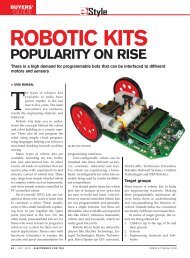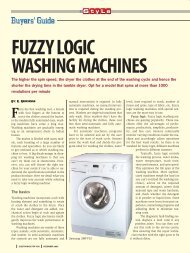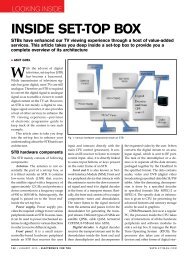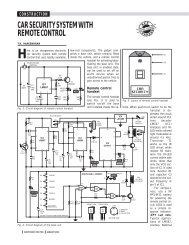Plasma Arc Gasification For Waste Management - Electronics For You
Plasma Arc Gasification For Waste Management - Electronics For You
Plasma Arc Gasification For Waste Management - Electronics For You
You also want an ePaper? Increase the reach of your titles
YUMPU automatically turns print PDFs into web optimized ePapers that Google loves.
ewaste<br />
Fig. 6: Alter Nrg plasma gasification system using WPC PGVR<br />
Fig. 7: Schematic of PEM process vessel with side-entry AC electrodes<br />
using multiple graphite electrodes,<br />
joule (resistance) heating using glass<br />
melter technology and superheated<br />
steam. This combination results in a<br />
stable and highly controllable treatment<br />
system.<br />
The plasma operates at temperatures<br />
from 3000°C to 10,000°C in an<br />
oxygen-free environment with the<br />
presence of superheated steam ensuring<br />
that pyrolysis and steam reforming<br />
reactions dominate. A high-efficiency<br />
scrubber is used to remove volatile<br />
metals and other pollutants from<br />
the hydrogen-rich product gas (100<br />
BTU/scf or more), a portion of which<br />
may be recycled to provide power<br />
to the PEM and<br />
the other portion<br />
used to generate<br />
electricity.<br />
Metals in the<br />
waste are recovered.<br />
The glassy<br />
aggregate is also<br />
recovered and<br />
may be recycled<br />
as road building,<br />
blasting grit<br />
or construction<br />
material. Volume<br />
reductions are up<br />
to 98 per cent depending<br />
on how<br />
the process is run<br />
and the composition of the waste.<br />
IET is more interested in treating<br />
radioactive, hazardous, industrial, municipal,<br />
tire, incinerator ash and medical<br />
waste streams. It has sold several<br />
commercial PEM units throughout the<br />
world to process a wide range of waste<br />
materials. <strong>For</strong> details, visit ‘www.inentec.com/commercial.html.’<br />
The Solena Group. The Solena<br />
Group, a strategic partner of Westinghouse,<br />
uses the integrated plasma<br />
gasification combined cycle (IPGCC).<br />
It is a unique process that uses a<br />
patented plasma gasification vitrification<br />
(PGV) technology for conversion<br />
of low-value fuels/feed stocks<br />
(such as coal waste, petroleum coke,<br />
bio-mass and different waste forms<br />
including municipal solid waste)<br />
into a low-heating-value synthesis or<br />
syngas containing carbon monoxide<br />
and hydrogen gases. This gas is then<br />
employed as a primary fuel for a gas<br />
turbine.<br />
The IPGCC can also be viewed as<br />
a two-stage processor of an opportunity<br />
feedstock. The feedstock is first<br />
gasified (partially oxidised) in a gasifier<br />
using high-temperature plasma<br />
heating systems at atmospheric<br />
pressure. The gas is then cleaned and<br />
combusted (completely oxidised) in<br />
the gas turbine to produce electricity.<br />
The PGV reactor, in essence, cleans<br />
the solid/liquid and/or dirty fuels/<br />
feed stocks by converting them into a<br />
valuable byproduct fuel gas or syngas<br />
to power a gas turbine.<br />
The IPGCC system generally<br />
consists of four separate processes:<br />
feedstock handling, plasma gasification<br />
and vitrification, gas cooling and<br />
clean-up, and gas turbine combined<br />
cycle.<br />
The IPGCC system offers significant<br />
advantages over standard IGCC.<br />
By applying the PGV technology for<br />
gasifying the feedstock, the plasma<br />
heating system provides an independent<br />
and extremely powerful heating<br />
1 2 6 • Februa ry 2 0 0 9 • electronics for you w w w . e F y m a g . c o m








